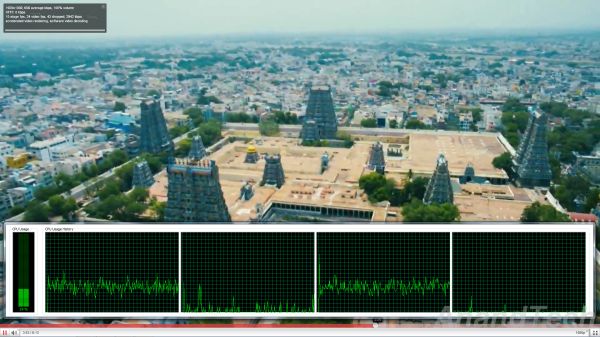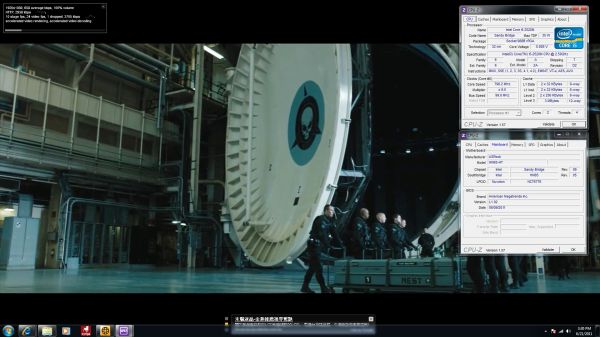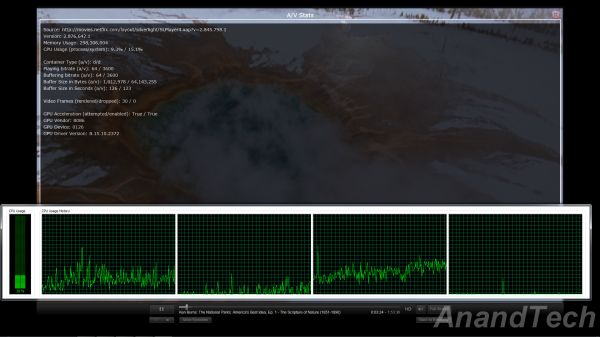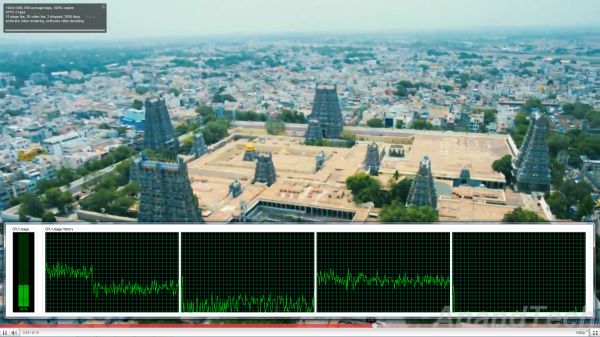ASRock CoreHT 252B Review
by Ganesh T S on September 2, 2011 3:45 AM EST- Posted in
- HTPC
- Intel
- ASRock
- Media Streamer
The ASRock CoreHT 252B is covered quite nicely with respect to networking hardware. With support for both Gigabit Ethernet and 802.11n, it really doesn't matter if you keep the unit beyond cable reach from the router. All our network streaming tests were carried out with a 300 Mbps 802.11n network (currently provided in my lab location by a RT-N16 802.11n gigabit router from Asus). We were easily able to stream HD clips of more than 50 Mbps. HD YouTube videos and HD Netflix streaming had no issues.
While on the topic of network streaming, let us take a brief look at how the system performs while accessing online video services. We used Flash 10.3 in Firefox 4 with Intel Graphics Driver v2372 for testing. The first set of screenshots below show the CPU usage while playing back a 1080p YouTube video with and without hardware acceleration enabled. This is the same clip used in all the other SFF HTPC reviews.
1080p YouTube HD Streaming without Hardware Acceleration

1080p YouTube HD Streaming with Hardware Acceleration (Flash in Firefox)
Unfortunately, enabling hardware acceleration in the Flash properties seems to result in only accelerated video rendering. The decode still ends up being done in software. This accounts for the ~5% decrease in CPU usage when hardware acceleration is enabled. Just before posting the review, we also confirmed that the issue still exists on IE9 / Firefox 6.0 with Flash 10.3.183.7. Another puzzling aspect was the fact that we could get hardware accelerated decoding for some videos occasionally.

1080p YouTube HD Streaming with Hardware Acceleration (Flash in IE9)
It looks like the Adobe Flash Player has some trouble in hooking up to the Intel DXVA library. Both AMD and NVIDIA platforms support GPU acceleration for Flash without issues. It is disappointing to note that the largest GPU vendor (in terms of install base) still hasn't got this working right.
Netflix streaming, on the other hand, uses Microsoft's Silverlight technology. Unlike Flash, hardware acceleration for the video decode process is not controlled by the user. It is upto the server side code to attempt GPU acceleration. Thankfully, Netflix does try to take advantage of the GPU's capabilities. This is evident from the A/V stats recorded while streaming a Netflix HD video at the maximum possible bitrate of 3.8 Mbps. While the video is definitely not 1080p, we observe that the CPU utilization of around 18% is lower than the CPU usage for a 1080p YouTube video.

Netflix HD Streaming with Hardware Acceleration
Users of media streamers streaming online videos often have to put up with messages of the sort 'This content is not available on TV connected devices' or need to queue up the videos on a PC before accessing them through their media streamer box. HTPC users don't need to worry about any such limitations.
On a side note, it is disappointing to see Netflix restrict its 1080p / DD+ 5.1 offerings to the PS3 and Roku 2. It is the PC platform which launched the streaming business for Netflix. It would be good if they do not relegate HTPC users to being second string consumers as their popularity grows.











54 Comments
View All Comments
uncola - Friday, September 2, 2011 - link
intel really needs to get their shit together re: dxva and hardware decoding for videovlado08 - Friday, September 2, 2011 - link
First I want to tank you Ganesh for the article. Keep the good work!Would you give us some more information please.
Can it play 1080 60p?
There are a lot of camcorders that can record in AVCHD v2.0 (1080 60p 28Mb/s).
What are the temperatures (CPU HDD) inside during idle and 100% load?
Why ASRock don't make CPU fan to blow outside the case as in notebooks?
Can you select RGB or YUV output in new intel drivers?
ganeshts - Friday, September 2, 2011 - link
Yes, it does play 1080p60 without issues (even the Clarkdales and Arrandales can do it).The 1080p60 streams are part of our test suite. But, yet, you are right .. I should have mentioned it.
The HTPC outputs RGB, and there is no obvious way to change it to YUV in the graphics control panel. However, the levels (0-255 / 16-235) can be modified with the Quantization Range option.
I will get back to you on the temperatures in a day.
vlado08 - Friday, September 2, 2011 - link
Thanks Ganesh, is 1080 60p hardware accelerated?ganeshts - Friday, September 2, 2011 - link
Yes, it is.Both 1080p60 and 16 reference frame H.264 videos were able to get DXVA2 hardware acceleration using the Microsoft DTV-DVD decoder.
ganeshts - Friday, September 2, 2011 - link
Here is the temperature info you requested (measured using the AXTU tool for the mobo and the CPU / HD Tune Pro for the hard disk in Celsiuis scale):Idle:
Motherboard : 42
CPU : 44
Hard Disk : 37
Prime95 + Furmark (after 15 minutes of activity):
Motherboard : 48
CPU : 83
Hard Disk : 39
tech6 - Friday, September 2, 2011 - link
I bought a previous generation HT100-BD and it was a fine HTPC but the ASRock service was appaling. The unit had two failed HDMI ports in the first 12 months and the second time ASRock demanded payment to fix it (even tough it was under warranty).As convenient as it may seem, I would go down the DIY route just for the flexibility of being able to fix it yourself.
Rick83 - Friday, September 2, 2011 - link
As paying the Windows Tax for a single purpose/ non-gaming machine is a bit pointless, I wonder how well the hardware in this box cooperates with Linux?I tried to build a HTPC on an older AMD platform and was continually being thwarted by driver issues (WLAN, sound, graphics), but here there actually may be an advantage, as Intel has a developer that manages libva, so their acceleration might work better on linux than DXVA..
Also XBMC has a native linux version which is quite nice and should even boot faster in an optimized system than a Windows system.
Vagn Henning - Friday, September 2, 2011 - link
As you might have noticed, the box ships without Windows. You see, that's the difference between your "Windows tax" and other taxes: You don't have to pay it. You are free to install any other OS. If you stopped pretending otherwise, someone might actually answer your question...Rick83 - Friday, September 2, 2011 - link
Well, the reviewer only used Windows, hence assuming that one pays for it.A Windows-only review is of little help for someone attempting to deploy linux on this box.
If the reviewer implies the windows tax, by not mentioning alternatives, he is the one accepting it, I am merely referring to his point of view.
Also, the alternative to the Windows tax is the Linux tax. The latter can often end up being higher....